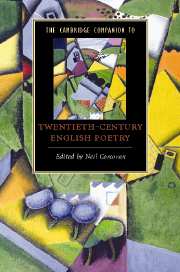5 - D. H. Lawrence’s place in modern poetry
from Part II - Moderns
Published online by Cambridge University Press: 28 January 2008
Summary
A visit to Eastwood
One weekend in 1970, during a family vacation cum research summer in London, my husband and I drove up to Nottinghamshire, to explore Lawrence country. I was in the midst of converting my dissertation on Lawrence's poetry into a book, so of course I wanted to see where 'my' writer came from - although, having read Lawrence so intensely for so long, I was pretty sure I knew what I'd encounter in the 'industrial Midlands'. Nor was I shocked when, as we approached Eastwood, we found ourselves facing several large, cone-shaped mountains of darkness: 'slag heaps', we realised. This was grimy mining country indeed, and these bleak black hills were outposts of a waste land shaped by the grim technology Lawrence decried in novels from Sons and Lovers to Women in Love to Lady Chatterley's Lover.
Yet I was surprised to discover that these huge mounds of debris were surrounded by greenery - by flowery meadows and by the ancient forests of Robin Hood. Even in Eastwood, when we located what we decided was the original Lawrence home, we saw that the 'Backs' he'd so vividly described still sloped down toward open country. Lawrence's Eastwood, I realised now with a certainty no library research could have produced, was a geography of paradox, as marked by the juxtaposition of untrammelled nature and constricting culture as this writer's entire literary oeuvre. In fact, Lawrence's whole body of work might be seen as an effort to drag the substance of nature - the bodies of men and women, of birds, beasts and flowers, even of fields and hills - out from under the shadow of those slag heaps reared by the tools of reason.
- Type
- Chapter
- Information
- Publisher: Cambridge University PressPrint publication year: 2007
- 2
- Cited by

